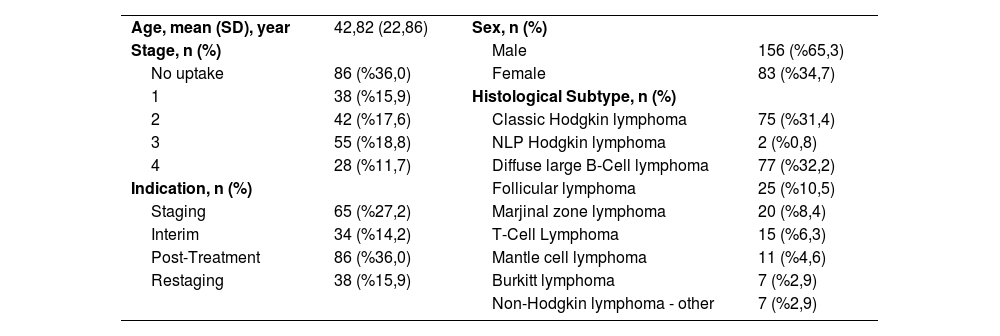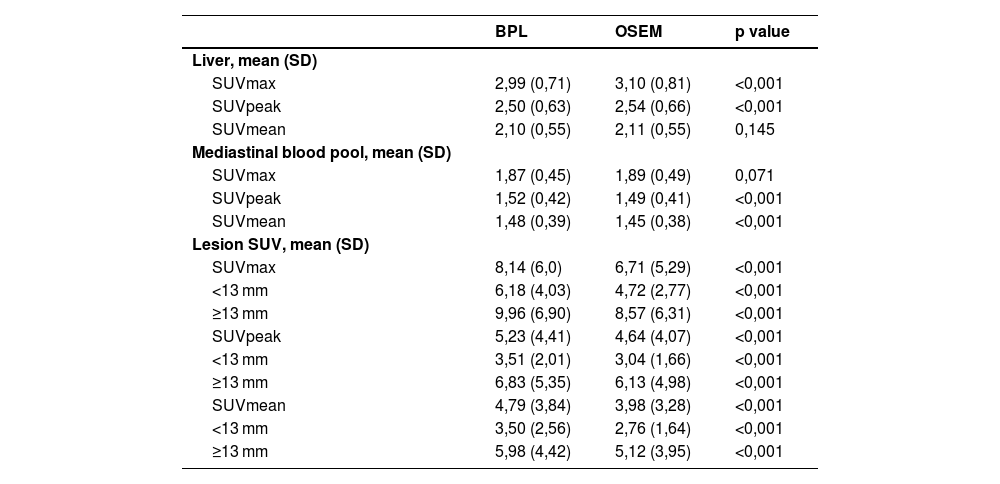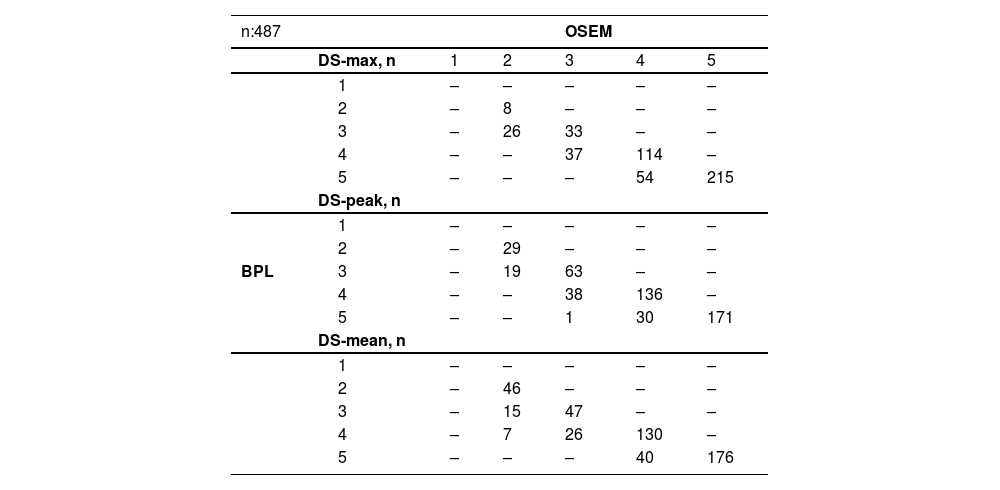18F-FDG PET with the Deauville score (DS) is a unique semiquantitative method for lymphoma. However, type of standard uptake values (max, mean, and peak) reconstruction algorithms could affect DS. We compared the Bayesian Penalized Likelihood reconstruction algorithm (BPL) with Ordered Subsets Expectation Maximization (OSEM) on quantitative parameters and DS in lymphoma. We investigated the effect of the size of the lymph node on quantitative variation.
Patients and methodsRaw PET data of 255 lymphoma patients were reconstructed separately with Q.Clear (GE Healthcare), a BPL, and SharpIR (GE Healthcare), an OSEM algorithm. In both images, each patient's liver, mediastinal blood pool, and SUVs (SUVmax, SUVmean, and SUVpeak) of a total of 487 lesions selected from the patients were performed. DSmax, DSmean, and DSpeak were compared.
ResultsIn our study, DS increased significantly with BPL (p < 0.001), and the DS increased to 4–5 in thirty patients evaluated as 1−2–3 with OSEM. It was found that the quantitative values of the lymph nodes increased statistically with BPL (p < 0.001), and the liver from the reference regions were significantly decreased (p < 0.001). In addition, difference in lymph node was independently associated with size of lesion and was significantly more pronounced in small lesions (p < 0.001). The effects of BPL algorithm were more pronounced in SUVmax than in SUVmean and SUVpeak. DS-mean and DS-peak scores were less changed by BPL than DS-max.
ConclusionDifferent reconstruction algorithms in FDG PET/CT affect the quantitative evaluation. That variation may affect the change in DS in lymphoma patients, thus affecting patient management.
la PET con 18F-FDG con la puntuación de Deauville (DS) es un método semicuantitativo único para el linfoma. Sin embargo, el tipo de algoritmos de reconstrucción de valores de captación estándar (máx., media y pico) podría afectar a la DS. Comparamos el algoritmo de reconstrucción de probabilidad penalizada bayesiano (BPL) con la maximización de expectativas de subconjuntos ordenados (OSEM) en parámetros cuantitativos y DS en linfoma. Investigamos el efecto del tamaño del ganglio linfático sobre la variación cuantitativa.
MétodosLos datos PET sin procesar de 255 pacientes con linfoma se reconstruyeron por separado con Q.Clear (GE Healthcare), un BPL y SharpIR (GE Healthcare), un algoritmo OSEM. En ambas imágenes, se midieron el hígado, el pool sanguíneo mediastínico y los SUV (SUVmax, SUVmean y SUVpeak) de cada paciente de un total de 487 lesiones seleccionadas de los pacientes. Se compararon DSmax, DSmean y DSpeak.
ResultadosEn nuestro estudio, el DS aumentó significativamente con BPL (p < 0,001), y el DS aumentó a 4–5 en treinta pacientes evaluados como 1−2–3 con OSEM. Se encontró que los valores cuantitativos de los ganglios linfáticos aumentaron estadísticamente con BPL (p < 0,001), y el hígado de las regiones de referencia disminuyó significativamente (p < 0,001). Además, la diferencia en los ganglios linfáticos se asoció de forma independiente con el tamaño de la lesión y fue significativamente más pronunciada en las lesiones pequeñas (p < 0,001). Los efectos del algoritmo BPL fueron más pronunciados en SUVmax que en SUVmean y SUVpeak. Las puntuaciones de DS-mean y DS-peak cambiaron menos por BPL que por DS-max.
ConclusiónLos diferentes algoritmos de reconstrucción en FDG PET/TC afectan la evaluación cuantitativa. Esa variación puede afectar el cambio en DS en pacientes con linfoma, afectando así el manejo del paciente.
Artículo

Revista Española de Medicina Nuclear e Imagen Molecular (English Edition)
Comprando el artículo el PDF del mismo podrá ser descargado
Precio 19,34 €
Comprar ahora










